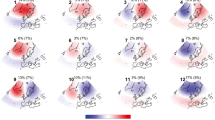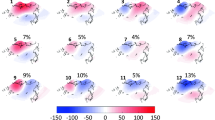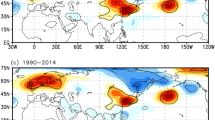Abstract
Surface weather conditions are closely governed by the large-scale circulation of the Earth’s atmosphere. Recent increases in the occurrence of some extreme weather phenomena1,2 have led to multiple mechanistic hypotheses linking changes in atmospheric circulation to increasing probability of extreme events3,4,5. However, observed evidence of long-term change in atmospheric circulation remains inconclusive6,7,8. Here we identify statistically significant trends in the occurrence of atmospheric circulation patterns, which partially explain observed trends in surface temperature extremes over seven mid-latitude regions of the Northern Hemisphere. Using self-organizing map cluster analysis9,10,11,12, we detect robust circulation pattern trends in a subset of these regions during both the satellite observation era (1979–2013) and the recent period of rapid Arctic sea-ice decline (1990–2013). Particularly substantial influences include the contribution of increasing trends in anticyclonic circulations to summer and autumn hot extremes over portions of Eurasia and North America, and the contribution of increasing trends in northerly flow to winter cold extremes over central Asia. Our results indicate that although a substantial portion of the observed change in extreme temperature occurrence has resulted from regional- and global-scale thermodynamic changes, the risk of extreme temperatures over some regions has also been altered by recent changes in the frequency, persistence and maximum duration of regional circulation patterns.
This is a preview of subscription content, access via your institution
Access options
Subscribe to this journal
Receive 51 print issues and online access
$199.00 per year
only $3.90 per issue
Buy this article
- Purchase on Springer Link
- Instant access to full article PDF
Prices may be subject to local taxes which are calculated during checkout




Similar content being viewed by others
References
Field, C. B. et al. (eds) Managing the Risks of Extreme Events and Disasters to Advance Climate Change Adaptation (Cambridge Univ. Press, 2012)
Donat, M. G. et al. Updated analyses of temperature and precipitation extreme indices since the beginning of the twentieth century: The HadEX2 dataset. J. Geophys. Res. 118, 2098–2118 (2013)
Francis, J. A. & Vavrus, S. J. Evidence linking Arctic amplification to extreme weather in mid-latitudes. Geophys. Res. Lett. 39, L06801 (2012)
Liu, J., Curry, J. A., Wang, H., Song, M. & Horton, R. M. Impact of declining Arctic sea ice on winter snowfall. Proc. Natl Acad. Sci. USA 109, 4074–4079 (2012)
Petoukhov, V., Rahmstorf, S., Petri, S. & Schellnhuber, H. J. Quasiresonant amplification of planetary waves and recent Northern Hemisphere weather extremes. Proc. Natl Acad. Sci. USA 110, 5336–5341 (2013)
Screen, J. A. & Simmonds, I. Caution needed when linking weather extremes to amplified planetary waves. Proc. Natl Acad. Sci. USA 110, E2327 (2013)
Barnes, E. A., Dunn-Sigouin, E., Masato, G. & Woolings, T. Exploring recent trends in Northern Hemisphere blocking. Geophys. Res. Lett. 41, 638–644 (2014)
Screen, J. & Simmonds, I. Exploring links between Arctic amplification and mid-latitude weather. Geophys. Res. Lett. 40, 959–964 (2013)
Kohonen, T. Self-Organizing Maps 501 (Springer, 2001)
Cassano, J. J., Uotila, P., Lynch, A. H. & Cassano, E. N. Predicted changes in synoptic forcing of net precipitation in large Arctic river basins during the 21st century. J. Geophys. Res. 112, G04S49 (2007)
Johnson, N. C., Feldstein, S. B. & Tremblay, B. The continuum of Northern Hemisphere teleconnection patterns and a description of the NAO shift with the use of self-organizing maps. J. Clim. 21, 6354–6371 (2008)
Lee, S. & Feldstein, S. B. Detecting ozone- and greenhouse gas-driven wind trends with observational data. Science 339, 563–567 (2013)
Diffenbaugh, N. S. et al. in Climate Change 2014: Impacts, Adaptation, and Vulnerability (eds Field, C. B. et al.) 137–141 (IPCC, Cambridge Univ. Press, 2014)
Field, C. B. et al. in Climate Change 2014: Impacts, Adaptation, and Vulnerability (eds Field, C. B. et al.) 1–32 (IPCC, Cambridge Univ. Press, 2014)
Shepherd, T. G. Atmospheric circulation as a source of uncertainty in climate change projections. Nat. Geosci. 7, 703–708 (2014)
Deser, C., Phillips, A. S., Alexander, M. A. & Smoliak, B. V. Projecting North American climate over the next 50 years: uncertainty due to internal variability. J. Clim. 27, 2271–2296 (2014)
Cohen, J. et al. Recent Arctic amplification and extreme mid-latitude weather. Nat. Geosci. 7, 627–637 (2014)
Palmer, T. Record-breaking winters and global climate change. Science 344, 803–804 (2014)
Wallace, J. M., Held, I. M., Thompson, D. W. J., Trenberth, K. E. & Walsh, J. E. Global warming and winter weather. Science 343, 729–730 (2014)
Screen, J. A. Arctic amplification decreases temperature variance in northern mid- to high-latitudes. Nature Clim. Change 4, 577–582 (2014)
Hartmann, D. L. et al. in Climate Change 2013: The Physical Science Basis (eds Stocker, T. F. et al.) 159–254 (IPCC, Cambridge Univ. Press, 2013)
Simmonds, I. Comparing and contrasting the behaviour of Arctic and Antarctic sea ice over the 35-year period 1979–2013. Ann. Glaciol. 56, 18–28 (2015)
Diffenbaugh, N. S. & Ashfaq, M. Intensification of hot extremes in the United States. Geophys. Res. Lett. 37, L15701 (2010)
Miralles, D. G., Teuling, A. J., van Heerwaarden, C. C. & Vila-Guerau de Arellano, J. Mega-heatwave temperatures due to combined soil desiccation and atmospheric heat accumulation. Nat. Geosci. 7, 345–349 (2014)
Diffenbaugh, N. S., Pal, J. S., Trapp, R. J. & Giorgi, F. Fine-scale processes regulate the response of extreme events to global climate change. Proc. Natl Acad. Sci. USA 102, 15774–15778 (2005)
Inoue, J., Hori, M. E. & Takaya, K. The role of Barents Sea ice in the wintertime cyclone track and emergence of a warm-Artic cold-Siberian Anomaly. J. Clim. 25, 2561–2568 (2012)
Mori, M., Watanabe, M., Shiogama, H., Inoue, J. & Kimoto, M. Robust Arctic sea-ice influence on the frequent Eurasian cold winters in past decades. Nat. Geosci. 7, 869–873 (2014)
Cohen, J., Furtado, J., Barlow, J. M., Alexeev, V. & Cherry, J. Arctic warming, increasing fall snow cover and widespread boreal winter cooling. Environ. Res. Lett. 7, 014007 (2012)
Screen, J. A., Deser, C., Simmonds, I. & Tomas, R. Atmospheric impacts of Arctic sea-ice loss, 1979–2009: Separating forced change from atmospheric internal variability. Clim. Dyn. 43, 333–344 (2014)
Screen, J. A., Simmonds, I., Deser, C. & Tomas, R. The atmospheric response to three decades of observed Arctic sea ice loss. J. Clim. 26, 1230–1248 (2013)
Screen, J. A. & Simmonds, I. Amplified mid-latitude planetary waves favour particular regional weather extremes. Nature Clim. Change 4, 704–709 (2014)
Kalnay, E. et al. The NCEP/NCAR 40-year reanalysis project. Bull. Am. Meteorol. Soc. 77, 437–471 (1996)
Kanamitsu, M. et al. NCEP-DOE AMIP-II Reanalysis (R-2). Bull. Am. Meteorol. Soc. 83, 1631–1643 (2002)
Dee, D. P. et al. The ERA-Interim reanalysis: configuration and performance of the data assimilation system. Q. J. R. Meteorol. Soc. 137, 553–597 (2011)
Driouech, F., Déqué, M. & Sánchez-Gómez, E. Weather regimes–Moroccan precipitation link in a regional climate change simulation. Glob. Plan. Ch. 72, 1–10 (2010)
Cattiaux, J., Douville, H. & Peings, P. European temperatures in CMIP5: origins of present-day biases and future uncertainties. Clim. Dyn. 41, 2889–2907 (2013)
Zwiers, F. W. & von Storch, H. Taking serial correlation into account in tests of the mean. J. Clim. 8, 336–351 (1995)
Anderson, T. W. & Darling, D. A. Asymptotic theory of certain “goodness-of-fit” criteria based on stochastic processes. Ann. Math. Stat. 23, 193–212 (1952)
Benjamini, Y. & Hochberg, Y. Controlling the false discovery rate: A practical and powerful approach to multiple testing. J. R. Stat. Soc., B 57, 289–300 (1995)
Box, G. E. P. & Cox, D. R. An analysis of transformations. J. R. Stat. Soc. B 26, 211–243 (1964)
Lehmann, E. & Romano, J. P. Generalizations of the familywise error rate. Ann. Stat. 33, 1138–1154 (2005)
Skific, N., Francis, J. A. & Cassano, J. J. Attribution of projected changes in atmospheric moisture transport in the Arctic: A self-organizing map perspective. J. Clim. 22, 4135–4153 (2009)
Acknowledgements
Work by D.E.H., D.S., D.L.S. and N.S.D. was supported by NSF CAREER Award 0955283, DOE Integrated Assessment Research Program Grant No. DE-SC005171DE-SC005171, and a G.J. Lieberman Fellowship to D.S. Contributions from N.C.J. were supported by NOAA’s Climate Program Office’s Modeling, Analysis, Predictions, and Projections program award NA14OAR4310189. B.R. acknowledges support from the US Air Force Office of Scientific Research (FA9550-13-1-0043), the US National Science Foundation (DMS-0906392, DMS-CMG-1025465, AGS-1003823, DMS-1106642, and DMS-CAREER-1352656), the Defense Advanced Research Projects Agency (DARPA YFA N66001-111-4131), and the UPS Foundation (SMC-DBNKY). We thank B. Santer, J. Cattiaux, D. Touma, and J. S. Mankin for discussions that improved the manuscript. Computational resources for data processing and analysis were provided by the Center for Computational Earth and Environmental Science in the School of Earth, Energy, and Environmental Sciences at Stanford University.
Author information
Authors and Affiliations
Contributions
D.E.H. conceived the study. D.E.H., N.C.J., D.S., D.L.S. and N.S.D. designed the analysis and co-wrote the manuscript. D.E.H., N.C.J. and D.S. provided analysis tools. D.E.H. performed the analysis. B.R. provided and described the multiple hypothesis testing and transformation analysis.
Corresponding author
Ethics declarations
Competing interests
The authors declare no competing financial interests.
Extended data figures and tables
Extended Data Figure 1 2-, 4- and 8-node SOM analyses.
SOM-derived mid-atmospheric summer (JJA) circulation patterns (500 hPa geopotential height anomalies) over Europe using 2- (a), 4- (b) and 8-node (c) analyses. White boxed values show pattern frequencies in the top left and SOM node numbers in the top right. Time series of SOM circulation pattern occurrence (black (d yr−1)), persistence (blue (d event−1)) and maximum duration (red (d event−1)). The slope of the trend line (yr−1) and P values (in parentheses) are colour coded, with the values from 1979 to 2013 (solid trend line) displayed above those from 1990 to 2013 (dashed trend line). Statistically significant trends (5% significance level; Methods) are shown by bold fonts in the scatter plots. Geopotential height fields are sourced from the NCEP-DOE-R2 reanalysis33.
Extended Data Figure 2 16-node SOM analysis.
SOM-derived mid-atmospheric summer (JJA) circulation patterns (500 hPa geopotential height anomalies) over Europe derived from a 16-node analysis. White boxed values show pattern frequencies in the top left and SOM node numbers in the top right. Time series of SOM circulation pattern occurrence (black (d yr−1)), persistence (blue (d event−1)) and maximum duration (red (d event−1)). The slope of the trend line (yr−1) and P values (in parentheses) are colour coded, with the values from 1979 to 2013 (solid trend line) displayed above those from 1990 to 2013 (dashed trend line). Statistically significant trends (5% significance level; Methods) are shown by bold fonts in the scatter plots. Geopotential height fields are sourced from the NCEP-DOE-R2 reanalysis33.
Extended Data Figure 3 Geopotential height trends and thermal dilation adjustment.
a–d, Northern Hemisphere polar projections of 1979–2013 seasonal trends in 500 hPa geopotential heights (same as Fig. 1, reproduced here for convenience). e, Area-weighted trends in seasonal geopotential heights over the Northern Hemisphere and regional SOM domains. f–j, Trends in raw and detrended geopotential height SOM pattern occurrence (OCC), persistence (PER) and maximum duration (DUR) in units of d yr−1 yr−1 for domains and seasons highlighted in the main text. The magnitudes of the (removed) seasonal Northern Hemisphere trends can be found in e. Grid cells highlighted in grey contain trends significant at the 5% level (Methods). SOM circulation patterns are abbreviated as follows: A, anticyclonic; C, cyclonic; and combinations of the two represent dipole patterns and west–east configurations. Geopotential height fields are sourced from the NCEP-DOE-R2 reanalysis33.
Extended Data Figure 4 1979–2013 (satellite era) robust atmospheric circulation pattern trends.
Time series of circulation pattern occurrence (black (d yr−1)), persistence (blue (d event−1)) and maximum duration (red (d event−1)) from the NCEP-DOE-R2 reanalysis33: a, summer over Europe; b, summer over western Asia; c, summer over eastern North America; d, autumn over eastern Asia; e, autumn over western Asia; f, autumn over central North America; g, autumn over eastern North America; and h, spring over Europe. Statistically significant trends ((yr−1); 5% significance level; Methods) are identified by bold font in the scatter plots.
Extended Data Figure 5 1990–2013 (ice era) robust atmospheric circulation pattern trends.
Time series of circulation pattern occurrence (black (d yr−1)), persistence (blue (d event−1)) and maximum duration (red (d event−1)) from the NCEP-DOE-R2 reanalysis33: a, winter over western Asia; b, winter over central Asia; c, summer over western Asia; d, summer over eastern North America; e, autumn over western Asia; and f, autumn over eastern North America. Statistically significant trends ((yr−1); 5% significance level; Methods) are identified by bold font in the scatter plots.
Extended Data Figure 6 1979–2013 (satellite era) Northern Hemisphere extreme temperature occurrence trends.
Satellite-era extreme temperature trends (d yr−1 yr−1) for winter cold (a) and hot (b) occurrences; spring cold (c) and hot (d) occurrences; summer cold (e) and hot (f) occurrences; and autumn cold (g) and hot (h) occurrences. Trends are calculated from the NCEP-DOE-R2 reanalysis 2-m daily maximum/minimum temperatures33. Grid cells with statistically significant trends (5% significance level; Methods) are stippled.
Extended Data Figure 7 1990–2013 (ice era) Northern Hemisphere extreme temperature occurrence trends.
Ice-era extreme temperature trends (d yr−1 yr−1) for winter cold (a) and hot (b) occurrences; spring cold (c) and hot (d) occurrences; summer cold (e) and hot (f) occurrences; and autumn cold (g) and hot (h) occurrences. Trends are calculated from the NCEP-DOE-R2 reanalysis 2-m daily maximum/minimum temperatures33. Grid cells with statistically significant trends (5% significance level; Methods) are stippled.
Extended Data Figure 8 Sensitivity of pattern similarity to number of SOM nodes.
To determine an adequate number of SOM nodes, we follow a modified version of the methodology introduced by ref. 12, wherein the mean pattern correlation of all daily geopotential height anomaly fields and their matching SOM node patterns are computed for a suite of different SOM node counts (3, 4, 5, 6, 7 and 8), for all regions and all seasons (black dots). We also compute the maximum/minimum pattern correlation of daily geopotential height anomaly fields with their matching SOM node pattern (red dots) and the maximum/minimum SOM-pattern-to-SOM-pattern correlation (blue triangles). The goal is to select an adequate number of nodes such that: (1) the mean pattern correlation of all daily geopotential height anomaly fields is relatively large; (2) the minimum pattern correlation of daily geopotential height anomaly fields is relatively large; and (3) the maximum SOM-pattern-to-SOM-pattern correlation is relatively small. Similar to ref. 12, we find that four SOM nodes are generally sufficient to capture the different modes of atmospheric variability, but small enough that SOM patterns depict distinct circulations. Geopotential height anomaly fields are sourced from the NCEP-DOE-R2 reanalysis33.
Source data
Rights and permissions
About this article
Cite this article
Horton, D., Johnson, N., Singh, D. et al. Contribution of changes in atmospheric circulation patterns to extreme temperature trends. Nature 522, 465–469 (2015). https://doi.org/10.1038/nature14550
Received:
Accepted:
Published:
Issue Date:
DOI: https://doi.org/10.1038/nature14550
This article is cited by
-
Linkages of unprecedented 2022 Yangtze River Valley heatwaves to Pakistan flood and triple-dip La Niña
npj Climate and Atmospheric Science (2023)
-
Inter-seasonal connection of typical European heatwave patterns to soil moisture
npj Climate and Atmospheric Science (2023)
-
Heat extremes in Western Europe increasing faster than simulated due to atmospheric circulation trends
Nature Communications (2023)
-
Meteorological drivers of resource adequacy failures in current and high renewable Western U.S. power systems
Nature Communications (2023)
-
Increased impact of heat domes on 2021-like heat extremes in North America under global warming
Nature Communications (2023)
Comments
By submitting a comment you agree to abide by our Terms and Community Guidelines. If you find something abusive or that does not comply with our terms or guidelines please flag it as inappropriate.



